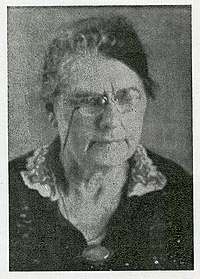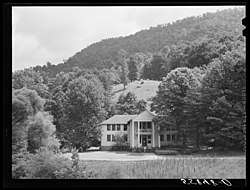Katherine Pettit
Katherine Rebecca Pettit (February 23, 1868 – September 3, 1936) was an American educator and suffragist from Kentucky who contributed to the settlement school movement of the early 20th century.[1]
Katherine Pettit | |
|---|---|
 | |
| Born | February 23, 1868 |
| Died | September 3, 1936 (aged 68) |
| Occupation | Educator, Writer, Collector of Appalachian customs, plants and artifacts |
| Known for | Founder of the nation's first rural settlement school |
Background
Born the child of Clara Barbee and Benjamin F. Pettit on a prosperous farm in Fayette County, Kentucky, Pettit attended two years at Sayre School in Lexington. A member of the Woman's Christian Temperance Union, Kentucky Federation of Women's Clubs and the Daughters of the American_Revolution, she became a progressive educator.[1][2]
Settlement schools
Under the auspices of by the Kentucky Federation of Women's Clubs beginning in 1899, Katherine Pettit and May Stone spent three summers in social settlement work in Kentucky at Camp Cedar Grove, Camp Industrial (which later became the Hindman Settlement School), and Sassafras Social Settlement. Their journals, filled with words to local ballads and idiomatic expressions of their students and families from homes nearby, describe in detail their classes in health and homemaking, as well as teacher training.[3] A local elder Solomon Everage watched the two women—"quare fotched-on women from the level land,"[4]—for some time and eventually asked them to establish a permanent industrial school in the Troublesome Creek area.
Hindman Settlement School
In 1902 with financing from Frances Beauchamp, president of the Kentucky Woman's Christian Temperance Union,[5] Katherine Pettit and May Stone co-founded Hindman Settlement School in Knott County, Kentucky.[2] Pettit said that the goal of Hindman was "to know all we can and teach all we can."[6] The Kentucky WCTU sponsored the school until 1915, when it was formally incorporated as a private, non-profit, non-sectarian, and non-denominational corporation.
May Stone remained at Hindman as principal until 1936. Many of the graduates remained in the area. Carl D. Perkins, a native of Hindman who served thirty-six years in the United States House of Representatives, was a graduate of the settlement school.
Pine Mountain Settlement School

In 1913, Pettit co-founded Pine Mountain Settlement School with Ethel deLong Zande in Harlan County, Kentucky. At Pine Mountain, Pettit directed outdoor work and agricultural education while Zande directed classical academics.[2]
Founding Pine Mountain as an example of the settlement movement, Pettit and deLong modeled the school after Hull House.[7] According to Berea College's Southern Appalachian Archives,
[Pettit and deLong] hoped that their modern ideas about health, nutrition, work efficiency, farm management, and the cultural value of indigenous crafts would permeate the surrounding communities -- both through the children, and through direct contact with adults.[7]
Pine Mountain Settlement School is a National Historic Landmark.[8]
Support for Woman Suffrage Movement
The publications officer for the Kentucky Equal Rights Association, Lida Calvert Obenchain reported to the state convention in 1908 that she sent suffrage literature to the settlement school in Hindman because she considered it a good "field for suffrage work." Obenchain reported:
- Miss Katherine Pettit, one of the teachers, is in sympathy with our cause and assures me that she can make use of all the Woman's Journals, copies of Progress and leaflets that I send her, so that these mountain girls and boys can hear the gospel of equal rights while they are growing up and will need no conversion in later life. I have also sent to this school the peace literature sent me by the Superintendent of this branch of work.[9]
In 1914, despite the antipathy for women's involvement in eastern Kentucky politics, Pettit was elected as a public school trustee in Harlan County, Kentucky.Greene III, James S. (1982). Progressives in the Kentucky Mountains: The Formative Years of the Pine Mountain Settlement School, 1913-1930 (PhD). Ohio State University. p. 293.</ref>
Pettit's activism in electoral politics and her support for women's right to vote clearly had an impact on her students. Even after she had left Hindman to work at Pine Mountain, the students in Hindman continued to focus on this volatile issue. Evelyn K. Wells, school secretary at Pine Mountain, visited Hindman Settlement School in 1918 and wrote about hearing the students working on their ideas about suffrage: "In the evening various clubs held forth. I visited debating and heard a most vigorous debate on woman suffrage..."[10]
Appalachian culture
Katherine Pettit labored to preserve and encourage the teaching of Appalachian culture through arts, folk songs, and customs.[2] One of her hobbies was collecting quilts (several of which are now displayed in the Bodley-Bullock House in the Gratz Park Historic District), as well as the folk tales and ballads of the region. Her diaries provide much detail about Appalachian culture at the beginning of the 20th century.[11]
Her teachings on natural vegetable dyeing were recorded in The Katherine Pettit Book of Vegetable Dyes. Wilmer Stone Viner, who had worked at Pine Mountain Settlement School, published this in 1946 after moving from Kentucky to Saluda, North Carolina. Consequently, Pettit's recipes have influenced craft practices in western North Carolina.[12] The book, dedicated to the memory of Katherine Pettit, quotes a memorial tablet in the Pine Mountain Settlement School Chapel:
Katherine Pettit, 1869 - 1936, pioneer and trail-breaker. Forty years she spent creating opportunity for mountain children here and elsewhere. In life, she ever refused praise. In death, she is too great for it.[13]
Death
Whenever she visited her sister Minnie Pettit Bullock in Lexington, she lived in the garden apartment behind the house in the Gratz Park Historic District.[14] She died of cancer there in 1936, and is buried in the Lexington Cemetery.[15]
References
- "Katherine Pettit". Encyclopædia Britannica online. Retrieved 2008-03-26.
- "Educators: Katherine Pettit". Women in Kentucky. Retrieved 2008-03-24.
- See The Quare Women's Journals: May Stone & Katherine Pettit's Summers in the Kentucky Mountains and the Founding of the Hindman Settlement School, Jess Stoddart, ed. Ashland, Ky.: Jesse Stuart Foundation, 1997.
- Tabler, Dave. "Kentucky's fotched-on women," (September 8, 2010) Appalachian History: Stories, quotes and anecdotes. Accessed December 12, 2010. www.appalachianhistory.net/2010/09/kentuckys-fotched-on-women.html Archived 2015-06-26 at the Wayback Machine
- Project, Kentucky Woman Suffrage. "Frances Estill Beauchamp, 1857-1923, Kentucky suffragist, temperance leader and philanthropist". H-Kentucky network. H-Net.org. Retrieved 31 March 2020.
- "Mission & History". Hindman Settlement School. Archived from the original on 2008-05-19. Retrieved 2008-03-26.
- "Southern Appalachian Archives: Guide to Pine Mountain Settlement School Collection". Berea College. Retrieved 2008-03-24.
- "About PMSS". Pine Mountain Settlement School. Archived from the original on 2008-07-03. Retrieved 2008-03-24.
- Lida Calvert Obenchain (November 17, 1908). Report of Supt. of Press Work (Report). Kentucky Equal Rights Association, Report of the Nineteenth Annual Convention of the Kentucky Equal Rights Association Held at Richmond, KY November 17th and 18th, 1908. p. 12. Retrieved 31 March 2020.
- "EVELYN K. WELLS 1918 Excerpts from Letters Home – Horseback to Hindman". Archives. Pine Mountain Settlement School Collections. Retrieved 31 March 2020.
- "Finding Aid for The Bullock-Pettit Photographic Collection". ExploreUK. Special Collections Research Center, University of Kentucky. Retrieved 31 March 2020.
- "Katherine Pettit". Hunter Library Digital Collections. Retrieved 2008-03-24.
- "The Katherine Pettit Book of Vegetable Dyes". Hunter Library Digital Collections. Retrieved 2008-03-24.
- "Finding aid for The Bullock-Pettit Photographic Collection". ExploreUK. Special Collections Research Center, University of Ky. Retrieved 31 March 2020.
- "Katherine Pettit". FindAGrave. Retrieved 31 March 2020.
Further reading
- England, Rhonda. "Voices From the History of Teaching: Katherine Pettit, Mary Stone, and Elizabeth Watts at Hindman Settlement School, 1899-1957." Ph.D. dissertation, University of Kentucky, 1990.
- Bullock-Pettit Family Papers, 1885-1968, 87M26, University of Kentucky Libraries, Lexington, Kentucky.
- Farr, Sidney Saylor. Appalachian Women: An Annotated Bibliography. Lexington: University Press of Kentucky, 1981.
- Katherine Pettit Papers, 1868-1937, KYSX216-A, Special Collections, Berea College, Berea, Ky.
- Katherine Pettit Papers, 1902-1934, MSC 37, Special Collections, Transylvania University, Lexington, Ky.
- Eberhardt, Ann Angel; Wykle, Helen Hayes. "Katherine Pettit". Pine Mountain Settlement School Collections. Pine Mountain Settlement School, Pine Mountain, KY. Retrieved 31 May 2016.
- Stoddart, Jess (2002). Challenge and Change in Appalachia: The Story of Hindman Settlement School. Lexington: University of Kentucky. Retrieved 31 March 2020.
[[Category:Kentucky women in education